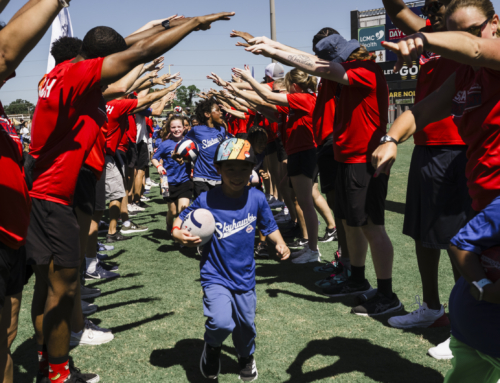Let’s say you’re a baseball coach, but not a “used to play minor league ball and have dedicated my life to the sport” type of coach. You’re more like, “I started coaching my son’s Little League team and, oh crap, what now?” If so, welcome. We’re here to help you not only learn proper baseball hitting mechanics, but understand how to teach them to kids—and provide you with some drills that reinforce those skills.
But even if you are a lifelong baseball coach, don’t go skipping off to some other part of the Internet just yet. This article can help you, too. How? Because in it, we’re going to simplify the process of teaching proper baseball hitting mechanics. Reading this piece will help you cut through the noise the next time you teach a kid how to hit. You’ll also bust through some common myths and errors. In fact, let’s start by breaking down the biggest one of all.
“You think that a young ballplayer needs to master baseball hitting mechanics in order to be a force at the plate, but really, the number one thing you need to teach your athlete is confidence,” says Bob Beck, director of baseball operations at T3 Performance in Avon, Ohio. “After that, the key isn’t so much to get every angle of the athlete’s body to look like Mike Trout. It’s to teach them how to use their body movements and athleticism to consistently make contact with the ball.”
Beck should know. He’s been coaching hitters at the middle school, high school, college and professional level for 20 years, and learned his approach by studying under several former MLB players and coaches including Torre Tyson, Joe Charboneau, Ryan Lehr, Reggie Smith and Matt Lyle. Here’s his approach for turning young ballplayers into monster batters.
Why Proper Baseball Mechanics Start in the Athlete’s Head
Ugh. You’re probably thinking right now. These guys want me to read a bunch of happy-dappy crap about mindset. I didn’t come here for a sports psychology lesson. Why does this even matter?
Here’s why: A good hitter has to be able to deal with the ups and downs of the game. Most kids see the MLB players they look up to on TV and recognize that the best ballplayers in the world only hit the ball successfully on three out of every 10 at-bats. They get that conceptually. But they often forget that fact when they experience it firsthand.
It’s easy for a young athlete to start getting down on himself when he’s failing on seven of 10 attempts. Soon, the player is going up to the plate thinking more about what they don’t want to do (here’s their internal monologue: “Don’t strike out. Don’t strike out. Don’t…”) rather than what they do want to do.
So what’s the solution? Give the athlete the tools they need to win at the plate mentally, then work on the physical stuff.
“I always tell young hitters that the key to gaining confidence is awareness and learning positive self-talk,” Beck says. “When they step into the box, they let go of thinking about their batting average. Their mind should be on one thing only: “Hit the ball hard somewhere.”
Beck points out two ways a coach can help a young athlete prepare for this mental side of the game.
-
First, take a “game day” approach to every swing during cage work. There are many players who look like Giancarlo Stanton in a batting cage but turn into Johnny Standstill come game time. How do you fix it? By turning cage work into a series of game day situations in your mind. “On every swing you take in the cage off the tee, front toss or live batting practice, you want to visualize and feel like you are competing against the pitcher. See the ball out of his hand, visualize the release point, and then take your swing,” Beck says.
-
Second, teach the importance of “learning time” before and during the game. What is learning time? It’s every pitch the opposing pitcher throws, and every at-bat that isn’t their own. Observe the pitcher’s tendencies, release points and the umpire’s strike zone. Notice what pitches are thrown at certain points in the count. “If you’re the ninth batter in the lineup, that means you’ve got eight at-bats to learn what’s coming your way,” Beck says. “When you step into the box armed with this knowledge, you’ll be the most prepared and confident player on the team.”
Making these changes can help an athlete feel ready to perform. “Now you’re going into the box with the mindset that ‘I’m going to do what I want to do’ rather than thinking about what you don’t want to do,” Beck says. “You’re stepping in the box thinking that, when the pitcher makes a mistake, you are going to make him pay.”
The Body Stuff: Turning Proper Baseball Hitting Mechanics Into Athletic Movements
The next step in teaching a young athlete how to hit requires you to shift your mindset a bit. It’s going to sound weird, but stick with us here: To teach a young player proper baseball hitting mechanics, you don’t actually want to think about mechanics. Instead, you want to think about “movements and feel.”
“The word mechanics implies that ‘X’ part of your body MUST BE HERE, or some other body part MUST BE THERE,” Beck says. “Efficient body movements that begin from the ground up (legs and core), on the other hand, allow a hitter to remain athletic and react to different pitch locations and speeds. They can see the ball well and be successful as a result of efficient movements.”
There are certain elements of hitting, such as the athlete’s stance, that are purely up to them. Whether or not they prefer a wide stance or a narrow stance is their choice. But what’s consistent across all batters, Beck says, are movements that allow a hitter to get into a strong hitting position, especially the “Load-to-Launch” phase of the six step hitting progression program Beck uses to teach hitters to be athletic at the plate. Those six steps are:
1. The Setup – The setup is a pre-pitch routine that you perform consistently the same way every time you come to the plate. “I like my players to do something before each pitch to get themselves mentally back in tune, like stepping out of the box, taking a practice swing, taking a deep breath, whatever,” Beck says. “It may seem silly, but it comes in handy when a player hits a ball poorly or swings ugly. Having a consistent routine is like hitting the ‘reset’ button, and keeps the mind nice and clear.”
2. Load – “Loading is the process of gathering energy,” Beck says. “At this point, you’re getting down into your legs and core by using the biggest and strongest muscles of your body. When a hitter gets down into their legs, their shoulders and head can’t rise, meaning you’re less likely to “pull” off the ball or take your eyes off the ball due to excessive head movement. Getting both heels connected to the ground prior to launch is the key.” You want to teach an athlete to load their legs on every pitch. Watch MLB players and you’ll see they do this on every pitch at every at bat. Their legs load so they have all of their power ready to swings should they want to do it.
3. Launch – The pitch is on the way and you like it. You’re going to take a swing at it. What’s next? The stride toward the ball. “As you stride, you are down into your legs and ready to deliver a controlled and powerful swing. The rotation of your hips is sending power to your shoulders and hands.”
Check out the video at the top of the article for a drill that reinforces the Load and Launch.
4. Contact – The point where you hit the ball is going to vary depending on pitch location and pitch speed. “Of course, you’re always trying to hit the ball on the sweet spot of the bat. The trouble is that’s hard to do,” Beck says with a smile. “The trick is to get the barrel of the bat on the same path as the pitch early. The trick to that is to see the release point of the ball.” All that visualizing the athlete has been doing at the batting cage should be helpful here.
Helpful Drill: STRIDE SEPARATION
5. Extension – Just like a track coach teaches his athletes to run through the finish line (rather than stop at it), you want to teach your athletes to drive through the ball when you make contact. “Hitters who don’t extend roll over a lot,” Beck says. “They wind up losing momentum, hitting the ball off-course, or missing entirely.”
6. Finish – The athlete’s goal at the end of the swing is to make a full 180-degree turn. “On a hitter who has an effective finish, you can see the name and number on the back of their jersey in the opposite batter’s box,” Beck says. “People think the batter’s belly button should be pointing at the pitcher when they’re done swinging, but really, it should be pointing at the third base dugout. We call that ‘swinging from “A to Z” rather than just swinging from “A to P.'”
Helpful Drill: FULL TURN
One final note: Work each of these drills in the cage enough, but not too much. That means about five to seven reps at a time, whether it be off the tee, front toss, or live batting practice. Between each round, have the athlete work on their setup, and remind them to visualize the release. As with all things, sound practice habits increase the chances of performing at top levels.
Article originally posted on stack.com
READ MORE:




